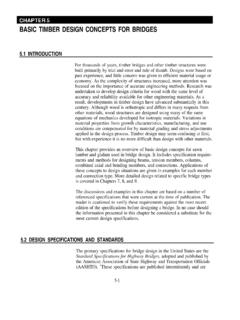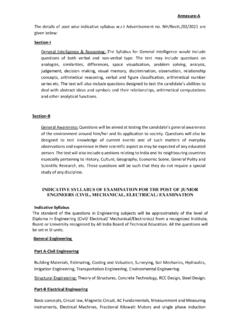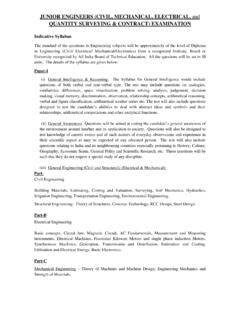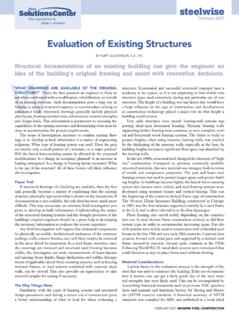Transcription of History, Nature, and Products of wood - EOLSS
1 FORESTS AND FOREST PLANTS Vol. II - History, Nature, and Products of wood - Youngs Robert L. HISTORY, NATURE, AND Products OF WOOD. Youngs Robert L. Professor Emeritus, Virginia Polytechnic Institute and State University, Blacksburg, Virginia, USA. Keywords: History of wood use, wood anatomy, wood physical effects, wood strength, round timber , lumber, wood-based composites, laminated wood Products Contents 1. Introduction 2. History of Wood Use 3. Nature of Wood Structure and Formation of Wood S. TE S. Physical Properties of Wood R. AP LS. Mechanical Properties of Wood Chemical Properties of Wood 4. Basic Forms of Wood and Wood-based Materials C EO.
2 Round timbers and poles and ties Lumber Wood-based Composites and Panel Products Glued Structural Members Structural Sandwich Construction E . H. Acknowledgements Glossary PL O. Bibliography M SC. Biographical Sketch 1. Introduction SA NE. Wood has been used and adapted by humans since the earliest recognition that they could make use of the materials they found around them. As they used it to meet a varying array of human needs, in peace and in war, in farming and in industry, people U. gradually came to understand something of the unique nature of wood. Its properties were first understood by experience, more recently by systematic research and refined observation.
3 Wood is still essential to human life, but has evolved over the ages from a simple, readily available natural material to a modern industrial and engineering material, with a unique ability to contribute to human life both as a material for use and as a key element in the natural world of the forest. 2. History of Wood Use The tree and its wood have played a prominent role in human life throughout history. Wood has been one of our most important building materials from early Paleolithic times, both for building and for the manufacture of tools, weapons, and furniture. From the earliest times, the use of wood involved consideration of quality, cost and availability, as well as the intended use of the product.
4 Scarcity of valuable timber led to Encyclopedia of Life Support Systems ( EOLSS ). FORESTS AND FOREST PLANTS Vol. II - History, Nature, and Products of wood - Youngs Robert L. careful and economic use. Boards were carefully matched and fitted; blemishes were removed and filled. Practices begun many centuries ago are still carried over, with refinement, to the current use of wood for high quality applications. Early humans used wood because it was available and no elaborate tools were needed to work it. In the early days, however, the quality of the Products depended more on the quality of the wood and the skill of the workman than on the tools available for woodworking.
5 The development of copper tools by about 5000 BC opened new opportunities for craftsmanship opportunities that have been carried forward to this day. From the tenth to the eighteenth centuries in Europe, wood was the material primarily used for buildings, tools, machines, mills, carts, buckets, shoes, furniture and barrels, to name just a few of the thousands of kinds of wood Products of the time. The first printing press was made of wood and such presses continued to be made of wood for a hundred years. Most of the machines and inventions to make possible the machine age were formed of wood during that period. In Europe, wood use reached a peak during the S.
6 TE S. sixteenth century, then began to diminish, not due to the limitations of wood, but due to R. AP LS. limits on its accessibility as a result of increasing demands for fuel and materials and the expansion of agriculture into formerly forested lands. Wood use in North America continued to expand long after the decline of use in Europe and continues to increase C EO. today as part of the general world trend toward increasing wood use. Many of the uses now take different forms, reflecting new product demands and new technology. Wood has historically played a key role in the transportation of people and their possessions, both as a fuel and as a raw material.
7 Sledges made of wood were used in E . northern Europe as early as 7000 BC. As wheels were invented in 3-4000 BC, this led to H. the development of carts. In the nineteenth century in North America, railroads used PL O. wood for fuel, as well as for sleepers, bridges, trestles, and vehicles. Fuel use on railroads contributed to wood being the primary energy source in North America at the M SC. middle of the nineteenth century. Wood for water transport evolved from the early barges and hollowed out logs of 4500 BC to the sleek sail-powered clipper ships of the mid nineteenth century. Steam for power and steel for ship construction made that SA NE.
8 Uneconomical by the end of the century, however. Wood has been a most versatile and useful construction material for thousands of years U. and is still used more than any other construction material. The style and durability of structures built at various times and places have depended on the type and quality of timber available and the conditions of use, as well as the culture and way of life of the people concerned. In forested zones, where timber was plentiful, solid walls were built of tree trunks or heavy timbers. timber houses in Neolithic Europe were frequently made by splitting logs and setting them vertically in the ground or on a sill plate on the ground.
9 Also thousands of years old is the concept of construction with logs placed horizontally, as in a log cabin. It has been used most frequently in the northern, central, and mountainous area of Europe and North America where there have been plentiful supplies of large, straight trees. As construction with stone and concrete became common, wood was used for concrete forms and supplementary structural components such as trusses and roof supports. Wood construction has had an interesting evolution in North America because of the relatively abundant timber resource and the scattered development of much of the country. Native Americans built homes of poles or planks.
10 Encyclopedia of Life Support Systems ( EOLSS ). FORESTS AND FOREST PLANTS Vol. II - History, Nature, and Products of wood - Youngs Robert L. The architecture of the early colonists from Europe used wood intensively, adapting the concepts used in their homelands to the cultural conditions of the times and the availability of materials. Wood remained the principal construction material in North America well into the nineteenth century and remains so for housing today, as it does in some other parts of the world where timber supplies are plentiful and the tradition of wood construction remains strong. Wood has been the dominant material for furniture construction since early times.
















